Why Roger Won
Wimbledon 2007
John Yandell
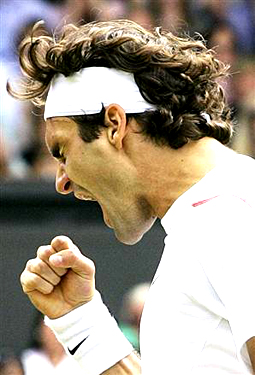 |
What can we learn from Roger's historic Wimbledon win? |
Is it too late to learn something from the incredible Wimbledon final of 2007 between Roger Federer and Rafael Nadal? I don't think so.
The lessons we can learn from this historic tactical and emotional battle are timeless and universal across levels. They may be even more applicable at the club level, as we'll see. But first let's try to understand the complex factors in this historic match, and what the numbers show.
It would be an understatement to say that I was thrilled for Roger Federer and that this was a sentiment shared by almost everyone I talked to who watched the match.
With Bjorn Borg there in that suit and tie, with Ted and Johnny Mac frequently talking more about the past than what was happening right in front of them, with all the downside that would have come with a loss, Roger Federer found the belief and the courage to take control at critical times.
A lot of people, including myself, have said I lot of things about the way Roger plays his matches against Rafa. He should hit more slice, more volleys, more aggressive returns, etc, etc.
But at two critical times, Federer changed up his tactical patterns in ways that surprised Nadal and this was probably the difference in a match that was so close it was literally decided by a handful of points.
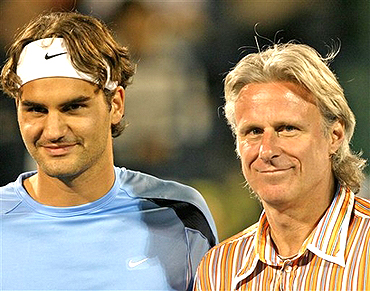 |
Could Roger tie the record with a living historical figure there watching? |
How close was it? In 5 sets, Federer and Nadal played 50 games and 2 tiebreakers. That was 323 total points. Roger won 165 points and Rafa won 158. So in the end Roger won 7 more total points.
Think of it this way. For every 45 points or so that they played, Roger won one more point than Nadal. On average, the difference per set was less than 2 points.
You can see more what happened with the numbers on a set by set basis in the Aggressive Margin statistics below. (To understand the Aggressive Margin and what it means, Click Here.)
Why?
After the French final, I said Rafael Nadal would win Wimbledon. Some people emailed to let me know I was crazy, but about the same number wrote to say they actually agreed. And I am happy to say I was wrong.
But, based on the French, I was sure of one thing that did prove true, if they played again at Wimbledon, it would come down to a matter of belief. Not so much Nadal's, but more Roger's.
Now that might seem like a strange thing to say about a player who has now won 11 Slam titles, but if you saw the French final, you may agree with me that, whatever can be said about the tactics there, in the end belief was the difference.
In the last article, I talked about the gamesmanship Nadal used before the match, blocking Federer on the platform before they went out on the court, and swinging those huge arms around like weapons. (Click Here.)
I've watched Roger in person and on TV for a long while, and one thing I've seen is when Roger really believes he can win, he almost always does. And when he losses confidence, he makes the kinds of puzzling errors and plays the kind of puzzling points he played at keys times in Paris.
And there is no doubt that in Paris and even before, Nadal did everything he possibly could--physically and psychologically, to undermine Roger's belief. And it seemed to work. (Click Here to read about how this started in Hamburg.)
That's why I thought their entrance on to center court at Wimbledon was so interesting. In Paris as they came up the stairs to go out on the court Roger was right behind Rafa. And we saw what happened there.
This time he stayed way back, about 10 feet behind, almost as if to say, I want nothing to do with whatever antics you may have in mind this time. And it seemed to work. Rafa went out to the edge of center court, but Roger didn't follow him. He just stopped and kept his distance. And this time Rafa only gave those guns a couple of half hearted swings.
Then Rafa tried to get Roger to walk out in front of him, but Roger politely refused. Better to keep Rafa in front of him where he could keep an eye on him. And when they walked out on court, that distance was still very noticeable.
Was this all coincidence? I doubt it. A brilliant psychological counter response played out in the Roger's unique, gracious style? That's what I sensed. Was it conscious or just intuitive? Who knows? But did it start the match off with a different feeling than Paris. Definitely.
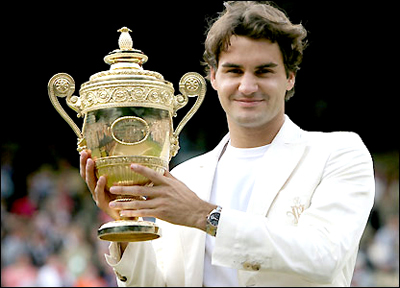 |
Roger's look tied him to history and his place within it.s |
I think what happened just before the match was actually just the last piece to Federer's psychological preparation.Last year at Wimbledon, Federer started with the retro tennis blazer, making a visual statement that tied him to the history of the game.
This year he built on that with the rest of the ensemble. And with the crosses on his shoes and on his bag representing his four titles, he took it even a step further. In the interview just before the match, when he was asked why he thought he would win, he said because of his great record at Wimbledon.
Losing that match at the French had to be incredibly painful, but it wasn't like when Borg lost to McEnroe in that second U.S.Open final and walked away from the game. Roger isn't done yet. He recovered from Paris and then prepared himself incredibly well psychologically for Wimbledon. As for his tactics, we'll get to that.
First Set
How close was the first set? At 7-7 in the tiebreaker, Federer and Nadal were literally tied at 41 points each. Roger won the last 2 points to take the set, so the final point total was 43-41, a 2 point edge for Roger out of 84 total.
But the first set actually seemed more like 3 different sets. Roger started the match and held serve. Then he got an immediate break in a long second game. He held again for 3-0. But then Nadal held easily, and broke back with a series of incredible running passes. Then Nadal held again. At that point it felt like they were back to square one.
in phase 2, they stayed on serve til 5-5. With Rafa serving at 4-5, Roger got within 2 points of the set at 15-30. But on the next point, they played an incredible 23 ball point, which Rafa won it with yet another impossible running pass, and then ended up holding.
So they started the contest one more time from 5-5. Both players were dominant in their next service games, and they rolled into what looked like it might be a spectacular breaker.
Roger started with an ace, then Rafael hit another one of those rocket passes. But on the next point Rafa tightened up noticeably and missed an easy backhand. Federer hit a service winner and then a gorgeous swinging forehand volley for a clean winner. Suddenly it was 4-1 Roger.
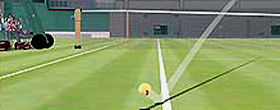 |
Hawk Eye: a number of important grass court reversals. |
Nadal hit a service winner, but then made another error off the ground, this time on a forehand. So it was 5-2 Roger. That looked like the tipping point. But Nadal, with characteristic daring, surprised Roger and came in on the next point and hit a backhand volley winner. Roger then answered with a clean forehand winner.
So Rafa was now serving, down 3-6. He hit a forehand winner. Then it was Roger's turn to tighten up and miss a relatively easy backhand return on a second serve.
But Roger still got to serve at -6-5. And he appeared to win the set when Nadal miss hit a down the line backhand that was called out. But Nadal challenged and got a Hawk Eye overrule. I'm a big believer in Hawk Eye but that was the first of a number of calls that seemed like ultra close overrules on a grass court with chalk lines.
Having a set point taken away on a dubious call is the kind of painful event that can destroy even an experience player and turn a match completely around. And it looked like that might happen. Clearly frustrated, Federer made a forehand error on the replay point and it was suddenly 6-6.
But then Roger pulled it together and hit a strong inside out forehand that got an error out of Nadal and got to set point again. On the next point Roger hit a couple of great crosscourt backhands, including a vicious, skidding slice. But Nadal neutralized them both, and Roger went for too much and made an error on a backhand down the line.
So that took it to 7 all in the breaker, with both players having won 41 points. What happened next? With Nadal serving in the deuce court Roger hit a gorgeous inside out power backhand return off a first serve. Nadal couldn't handle it and made a backhand error.
Now serving for the set again, Roger hit a first serve in and then ripped a couple of crosscourt forehands with what could only be called complete abandon. Suddenly he was on top of the net and hitting a backhand volley crosscourt for the set.
Aggressive Margin 1st Set |
|||||
Aggressive Margin: |
Forehand |
Backhand |
Serve |
Net |
Total |
Federer |
+3 |
-1 |
+13 |
+4 |
+19 |
Nadal |
+8 |
+1 |
+6 |
+2 |
+17 |
Ask yourself how hard it must be to swing that freely on a point of that magnitude. He gave it the Roger pump and it looked like he had found that confidence I was talking about. But that was about to change.
2nd Set
Roger started off the first game of the second with a bang, approaching and hitting an overhead winner on Nadal's serve. But then Nadal won 4 straight points to hold.
Then Roger held easily himself. As did Nadal in the next game, hitting a great stretch backhand volley, and then a very difficult half volley that had Johnny Mac comparing him with Stefan Edberg. Another routine game for Federer took it to 2-2.
In Nadal's next service game, they played another incredible backcourt point exchanging almost 20 of the hardest, cleanest grasscourt groundstrokes ever. But Federer ended up hitting a forehand 3 feet long and it turned into another easy hold. 3-2 Nadal.
Then at 15-30 on Federer's serve, Nadal got his second Hawk Eye overrule of the match. Roger hit a first serve that appeared to hit the line, but was ruled wide on appeal. Roger shook his head, hit a second serve, and they played a long backcourt point that ended with Roger making a backhand error. Double break point, 15-40.
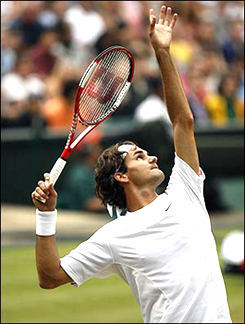 |
Clutch aces and service winners time after time, all match long. |
But Roger erased the first breaker with a silky smooth ace down the T. Then he hit another clean ace wide in the ad court. And then, something I don't remember ever seeing him do, he hit a third effortless ace in a row. Another long backcourt point ended with a Nadal error, and it looked like Roger might have thwarted a serious surge to get to 3all.
Nadal held again, with Federer losing a challenge on game point. There was no way to tell there was even more Hawk Eye drama ahead, but already Roger didn't look too happy about it. Still he held serve to make it 4-4.
The small breaks kept going Nadal's way. On the first point of the next game, Nadal got lucky with a forehand net cord pass. Then at 15all, Nadal hit a nasty one-handed slice backhand pass that Federer couldn't handle. I'd never seen him even try that one. Roger hit a great backhand return on a first serve in the ad court to get to deuce, but Nadal still held when Federer made first a backhand then a forehand return error. So it was now 5-4 Nadal.
So Roger had to try to hold to get to 5 all, but he couldn't do it. Rafa got yet another volley let cord winner. Then he hit a backhand crosscourt pass while in the process of falling down on the court. He backed that up with a little fist pump from a sitting position.
That got to Roger. He hit a forehand two feet wide to give Nadal double break point. Then Nadal got the break and the set by hitting another unbelievable backhand pass down the line. 6-4 Nadal and one set each. But my question was, who believed what now?
Third Set
This was the closest thing to a routine set they played, if any set in a Wimbledon final could be called routine. It went all the way to the tiebreaker without a service break, or even a break point. Most of the points were more or less straight forward power backcourt tennis, with both players working the crosscourts, looking for slight advantages and hitting into the openings for winners or forced errors or approaches.
Aggressive Margin 2nd Set |
|||||
Aggressive Margin: |
Forehand |
Backhand |
Serve |
Net |
Total |
Federer |
-0 |
-6 |
+6 |
+3 |
+3 |
Nadal |
+2 |
+3 |
+3 |
+2 |
+10 |
At 3-3 with Nadal serving, Roger got to 30all. And at 4-5 on Roger's serve Nadal had a deuce point. But that was as close to a break as either player got, and they both basically cruised into another tiebreaker. You had the feeling this one was going to be critical.
With Nadal serving to start the breaker, Federer grazed the sideline with an inside out forehand winner to get an immediate mini-break. He then hit a short forehand for another winner for 2-0. But Nadal cleaned a Federer second serve for a short angled inside out forehand winner of his own, a shot that was so dominating Federer didn't even take a step toward the ball.
That made it 1-2 in the breaker, with Nadal serving in the ad court. And here is where the tactics came in. To me this next point turned the breaker, if not the direction of the entire match.
Nadal hit a fault and then on his second serve, Roger ran way around the ball and hit an inside in forehand return down the line. Nadal got around the ball himself and they exchanged forehands up the middle. Then Nadal hit another forehand, this time inside in up the line to Roger's backhand, leaving the court open. But instead of driving the ball crosscourt into the opening, Roger hit a deep slice down the line. The ball seemed to surprise Nadal, who managed to get around it again for another forehand, but hit the ball an inch long.
This was one of the few times in the match Roger didn't follow the logic of working the openings. Instead he played an extra ball down the line to Nadal's forehand, something that was a cornerstone of his success in Hamburg. (Click Here.) Although he had hit a few balls down the line off his backhand over the course of the match, he hadn't done it consistently and it hadn't yielded anything dramatic. But it really paid off now. And this wasn't the last time in the match it produced a critical result.
That point gave Federer 3-1. Nadal won the next point on serve, but Roger was now serving with a 3-2 lead. That was all he needed. Looking almost inhumanly relaxed, he hit a clean ace in the ad court, and then a gorgeous, unreturnable wide service winner in the deuce court that made it 5-2.
For the first time, Rafa showed what appeared to be a note of frustration. A few moments ago it had been 2-2. But Roger had suddenly taken the breaker away from him with a surprise tactic and two unplayable serves.
On the next point, Nadal missed a short backhand about 5 feet long to go down 6-2. Roger missed an easy backhand on the next point, but then he hit a gorgeous short crosscourt backhand angle that Nadal couldn't handle. And that was the breaker by the score of 7-3. And that made it 2 sets to 1 Federer.
Aggressive Margin 3rd Set |
|||||
Aggressive Margin: |
Forehand |
Backhand |
Serve |
Net |
Total |
Federer |
+3 |
-2 |
+12 |
+5 |
+18 |
Nadal |
+2 |
-2 |
+7 |
+1 |
+8 |
4th Set
But did you really think it was over? Roger served first and won the first two points on 2 more unreturnable serves, gorgeous, like in the breaker.
But then he missed a relatively easy forehand volley. Nadal hit a backhand pass. Roger shanked a forehand badly, and it was break point. Then Nadal moved in on a first serve, hit an unplayable forehand return, and sprinted over to his chair with a fist pump and the break. He then held easily for 2-0.
In the next game at 30 all on Roger's serve, incredibly, the Hawk Eye factor emerged again--with the biggest impact yet. Nadal hit a forehand that was called out, a ball the chair umpire said he saw long as well. But Nadal challenged, and the Hawk Eye replay showed the ball had nicked the line by a millimeter or maybe less.
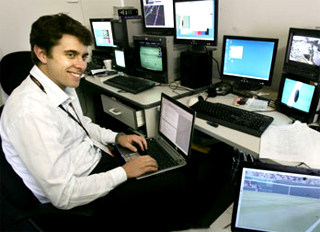 |
Paul Hawkins, creator of Hawk Eye, probably never envisioned this debut at Wimbledon. |
Roger walked calmly up to the chair umpire, told him the ball was out and then asked him to turn Hawk Eye off. He had to know that was futile. He lost the game and now Nadal was up 3-0 with two breaks.
On the change over Roger wasn't so calm, telling the chair umpire in an agitated tone that Hawkeye was "killing him." I don't think that was quite the way Hawk Eye inventor Paul Hawkins, the brilliant young English guy with a PhD in artificial intelligence, had imagined his Wimbledon debute.
Nadal held easily and that made it 4-0. Now Roger's demeanor became noticeably more casual. He made another sarcastic comment about Hawkeye, but somehow still held for 4-1 Nadal.
Now there was another sudden surprise. Nadal, who had sailed through the second week of the tournament playing everyday called for an injury time out. The replay showed him coming up hobbling in the last point, and the trainer wrapped his leg right below his right knee.
In the next game it looked pretty ominous. Rafa appeared unable to go all the way down in his front knee on his serve, he didn't run for a wide backhand he would have previously covered, and he was visibly limping after at least one point.
Still he held for 5-1. Then Federer held again, helped by some return errors from Nadal, who appeared to be trying to just blast winners and/or get the game over.
So Nadal had to serve to 5-2 to force the 5th set. He held easily, and it was hard to see if his leg was still bothering him. Roger still appeared de-energized--or possibly he was just idling and preparing for the inevitable fifth.
Aggressive Margin 4th Set |
|||||
Aggressive Margin: |
Forehand |
Backhand |
Serve |
Net |
Total |
Federer |
-2 |
-2 |
+8 |
-1 |
+3 |
Nadal |
+6 |
+1 |
+3 |
+1 |
+11 |
Fifth Set
So how would Nadal respond physically in the fifth? How would Roger respond emotionally?
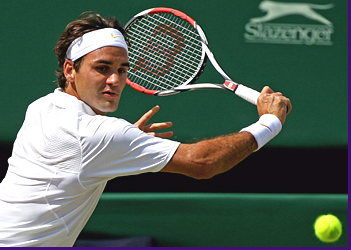 |
In the 5th set, playing with a different look on his face. |
Between sets Nadal took another break and probably had his knee retaped. According to Ted Robinson, the diagnosis was patella tendonitis. I've had that myself, as have most competitive players at some point. It's basically a sore point on the front of your leg just below your knee cap.
If it's not really bad, taping it with some pressure over that point usually takes the pain away sufficiently so you can move normally--at least during a match when you are flooded with adrenaline. And that appeared to be what happened with Nadal. The knee really didn't seem to bother him, and everyone just kind of forgot how bad it had looked two games before.
But the injury time out could have also helped Federer. It gave him a little more time to recover psychologically. At the start of the fifth, he had that serene look on his face again. He played an impeccable first service game, hitting 3 service winners and holding at love.
Nadal held easily too. Then in the next game you got an even better sense of how Roger was feeling. He looked like he would be broken for sure but came back--and it was the way he did it that gave the real indication.
On the first point he hit a short forehand approach and then an extremely difficult stretch backhand volley for a winner. Rafa answered with a monstrous inside out forehand winner, and a visible sneer. Then Rafa hit an amazing short angle crosscourt forehand pass. At 15-30 Rafa hit a huge forehand return off a first serve that Roger couldn't handle.
So now it was double break point. Roger got out of it with tennis that showed he was ready to play again at the level of the first and third sets, or higher if necessary. He hit a wide first serve that didn't come back, then an almost unbelievable running crosscourt forehand. Not only did he run the ball down, he looped it so deep with so much spin that Nadal mishandled it and made an error.
Nadal didn't like that at all, and made an easy backhand error on the next point. So from two break points down it was now ad in. Then Roger hit another confident looking forehand into the open court to hold for 2-1. You got the feeling that Nadal had forced a window open and thought he could climb through, but was a little shocked when Federer slammed it in his face.
But Nadal wasn't giving up. And he almost pried that window open one more time. On the first point on his serve in the next game, he hit a very tough low backhand volley winner and made it look routine. He was up there again on the next point and banged an overhead, and he ended up holding easily for 2 all.
In the next game, he got to 15-40 on Roger's serve for the second time in a row, mainly through backcourt errors from Roger. You had to think this time he'd get through.
But then Roger hit an unreturnable second serve. Then he hit an unreturnable first serve. Nadal made a backhand error on a very makeable ball. Then they played yet another one of those sublime, heavy hitting backcourt points. It was corner to corner, but it ended with Federer hitting a dominating forehand.
So that was 4 break points gone. And now the iron will of Rafael Nadal finally wavered. In his service game at 2-3, Rafa missed a forehand angle when the ball clipped the tape. Then Federer hit another running forehand winner, passing Nadal cleanly up the line.
If you believe in body language that shot was a huge turning point. I'd never seen Rafa do it before, but he looked up at the sky, then dropped his head all the way down, as if he believed that events had progressed beyond his control.
Federer hit another clean forehand winner, then missed a backhand. That made it 15-40. And now, he pulled out the extreme version of his secret strategy.
First he chipped a forehand return crosscourt toward Nadal's backhand. Not surprisingly Nadal ran around it and hit a forehand inside in down the line. Federer got to it easily, and even though the crosscourt was open, he went back down the line with his backhand.
Then Nadal did the same thing--hit his backhand right back down the line to Federer. Roger floated a backhand slice back down the line. Nadal ran around this one and--you guessed it--hit a forehand inside in, back down the line. It looked crazy after they had been running corner to corner for 3 hours. It was like they were doing a sideline control drill in the middle of a Wimbledon final.
But Rafa's inside in forehand curved a little more to the middle. Now Federer ran around it and stuck a forehand--yes-back down the line inside in! So that was 6 balls in a row down the line.
Nadal couldn't stand it anymore and ripped a crosscourt backhand. But Federer ran it down and hit a crosscourt forehand back to Nadal, still standing in the corner! So Nadal did the logical thing and hit down the line into that big opening.
But Federer covered it and hit a low crosscourt slice that bounced just past the service line. Nadal got to it but had to flip the ball up since it was about 6 inches off the court. It landed crosscourt and short. And that was it. Federer ran around this one too and hit a perfect inside in forehand into the corner for a clean winner.
Now that was amazing. Federer had just come up with a huge point filled with unpredictable variety and I'm not sure Nadal even knew what hit him. But Federer knew. He let out a loud, long "Yes!" with a tone and a feeling that I hadn't heard since that backhand volley at set point in the first. You could see the confidence was flowing in a stream and that Roger really was going win his fifth Wimbledon in a row.
It was still only 4-2. But on Roger's serve in the next game, Nadal didn't even get a ball in play. Serving at 2-5, Nadal had two ads and it looked like Roger might have to serve for the match. But Roger got back to deuce both times with clean winners.
Roger then had his first match point and missed a forehand, but on the second one, he made no mistake, crushed a forehand volley, and that was it.
Aggressive Margin 5th Set |
|||||
Aggressive Margin: |
Forehand |
Backhand |
Serve |
Net |
Total |
Federer |
+4 |
-3 |
+9 |
+1 |
+11 |
Nadal |
0 |
-4 |
0 |
+1 |
-3 |
Despite everything, I still love Nadal, gamesmanship and all. And I still hope he wins Wimbledon. But is there anyone who ever deserved what he has achieved more than Roger Federer?
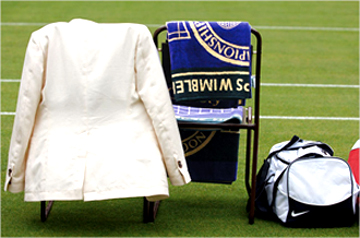 |
How you look and how you manage your equipment: part of who you are as a player. |
What You Can Really Actually Learn
And now as to those lessons we can all learn. You may never hit your forehand like Roger Federer, but I think there are four things virtually every player can learn about the psychological and tactical elements of winning matches from this final.
First, you have to believe that you can win. Sounds obvious, but how many players go into their matches really believing that? You have to do what you have to do to get your mind there.
That includes your physical preparation. It also includes your self-image. You may not have a 1920's tennis blazer designed just for you like Roger, but how you feel about how you look, how you deal with your shoes, your clothes, how you feel about your rackets, all that can play a big part. Believing is different than hoping or wishing. You have to feel the difference.
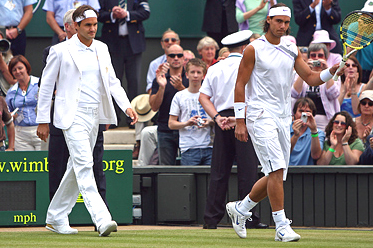 |
Do what you need to do to keep the other player out of your head. |
Unfortunately, this is a dimension most players never explore--sometimes it's easier to convince yourself that just one more piece of information on the forehand is going to do it, when really what is keeping you from your goals has to do with much scarier stuff--who you are and what you really believe about your tennis. For more on this, I highly recommend Jim Loehr's seminal articles, "From Negative to Positive," (Click Here) and "In Your Mind's Eye." (Click Here.)
Second, you need to have a plan for dealing emotionally with your opponent if, like Nadal, he or she uses psychological warfare as part of an overall game plan. Again this is going to depend on your personality. Some players may need to be more confrontational.
For Roger it was all about keeping his distance--physically and emotionally. He didn't let Nadal get close to him physically. Again, there is no way of knowing how conscious or deliberate it was, but I think it helped him keep Nadal out of his head. It let him stay focused on who he was, on playing his game, and on his date with history.
Third, you have got to be ready emotionally to deal with the unexpected. No one could have predicted that Hawk Eye would end up being such a big factor in this match--or that it would work so completely in Nadal's favor. Federer probably thought Hawk Eye cost him the fourth set. No doubt he was really upset.
But when the fifth set started, he had the strength to put that in the past and play his most unbelievable tennis yet, in what had already been an unbelievable match. Now be honest, how many times has something that-- in retrospect-- seems pretty trivial upset you in a league or a club match and caused you to unravel?
Finally, it looks like Roger knew a little bit more about match tactics and strategy than people were willing to give him credit for. He'd proven that working the ball down the line to Nadal's backhand, even when the court was open crosscourt would work, even on red clay.
He obviously remembered that and went into the match knowing it might work again. I don't think it was coincidence that at the two most critical junctures he had the courage to try it. Or that it worked.
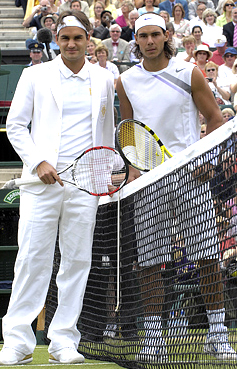 |
An Open final with these guys? Too much to hope for? |
If Roger had played the whole match constantly using this pattern it's doubtful it would have had the same surprise effect when the critical moments arrived. Somehow he just knew this. He changed it up suddenly, just at the right time, confused Nadal, and the result speaks itself.
How well do you know your own opponents? Could you--even theoretically--devise a similar strategy against them? Most players never figure out which patterns are most advantageous for them against different players, much less have the courage pull them out and execute them at just the right moment.
A suggestion here too if you want to explore these issues. Start with Allen Fox's amazing article on "Winning Baseline Exchanges," (Click Here) and then go on to the rest of the articles in that series. Move on from there to Craig Cignarelli's strategy series.(Click Here.)
Strategic thinking can be the difference in a match where the margin between two players is only a few points here and there--in a Wimbledon final and maybe even more so in a typical NTRP match. Hey, that's what Tennisplayer is here to help you understand!
So that's it for the amazing Wimbledon final, 2007. Could you stand it? Would it be too much to hope to see these two guys again in the final in New York? That would be the greatest gift to tennis fans in the last 40 years.




